Principles of Animation
28 Principles of Animation
This article was given to me by Mark Kennedy (storyboard artist on Hercules and Tarzan). Thank you Mark for all those handouts!!
Often times animators and storyboarders in the industry are able to get handouts from some of the artists who are great teachers. This is an example of such kind of handout that gets circulated among the artists gradually. It took me quite a while to retype and scan the images from this handout. Please don't reproduce this on the internet without permission. (if you'd like to print it out and give it to another animation student, however, PLEASE do!) The entire article from here on out is by Walt Stanchfield (sp?) I included the images in approximately the same spot as they were on the original hand-written article.
This is a wonderful article for not only beginners but also for practiced animators. Please read it.
There are some principles of animation that can be consciously used in any scene. We should familiarize ourselves with them for both animation and animation-cleanup.
To illustrate these principles, I have chosen a supposedly simple scene. When the scene is analyzed, it is apparent how far one may go in using these principles.
The action in this scene is quite broad, making the principles easy to find, but they should be applied to subtle scenes also. Rarely in a picture is a character doing nothing- absolutely nothing. Snow White and Sleeping Beauty spend a short time in complete inactivity, but even then certain of these principles were used.
The use of held drawings and moving holds can be very effective, but only if they contain the vitality of an action drawing. Again, the use of these principles makes that possible.
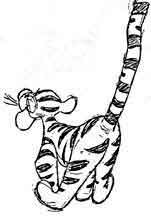
28 Principles of Animation
The purpose of studying and analyzing a scene like this is to acquaint oneself with the possibilites in the use of the principles of animation. I have listed 28 principles, though there well may be more. At first these will have to be used consciously, then hopefully in time will become second nature. These are the tools of animation and should be incorporated whenever possible. Some of them are accidentally stumbled upon while animating in an emotional spurt, but when the emotions are lax, knowing these principles will enable the artist to animate his scene intellectually, logically and artistically as well as emotionally.
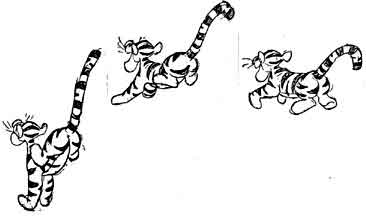
28 Principles of Animation
Here is a list of things (principles) that appear in these drawings, most of which should appear in all scenes, for they comprise the basis for full animation
|
|
|
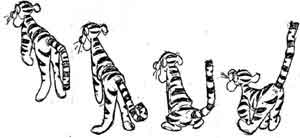
28 Principles of Animation
An example of the observations that might be made by flipping and studying just these two drawings. By shifting your eyes from one drawing to the other you can see these things happening. Watch the negative shapes also.
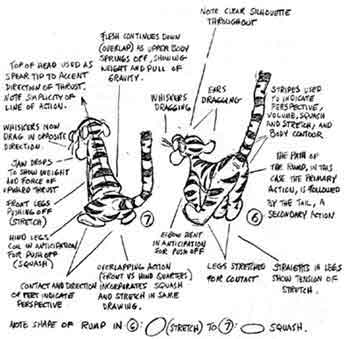
... To continue along this line of investigation...
This drawing would be called the "push off". Note that every line and shape on the drawing helps the upward thrust. Even the tail, which is still following the path set up for it by its primary force, the rump, helps by way of contrast and followthrough. Pick any shape on the figure and compare it to drawing #6 on the preceding page. Note how each shape changes to enhance the overall shape and action: the neck, the chest, the legs, the back, etc.
Even though this is just one drawing, there is no doubt about the action that is taking place in this part of the scene. This should be true of any drawing in any scene.
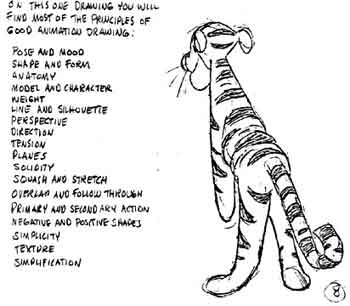
Consider Anatomy Alone:
Aside from its purpose in the scene each drawing can be analyzed for different aspects of drawing. The whole body is a caracature of an animal, but all the parts of a real animal are present i.e., head, neck, back, hips, tail, etc. And each of them work and move in a plausible way.
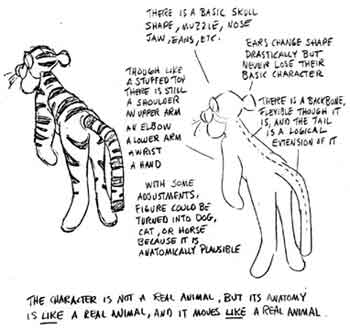
Anatomy Continued
Anatomy, of course is essential to any drawing whether it has a direct reference to nature or is completely imaginary. Though a character and/or its action may be greatly exaggerated or caracatured, anatomy in a sense remains fairly constant. An elbow is an elbow and only bends in a certain way, and has its limitation. Liberties may be taken but the "reality" of even a cartoon must be kept or it will lose plausibility or credulity. It is not an easy thing to convert one's knowledge of structural anatomy to the cartoon medium.
It has been said that the location of a joint is more important than the joint itself. For instane if an arm shape has been established, it cannot have an elbow bend in an improbable place, no matter how well the elbow is drawn. Compare tiger's arm to that of a real tiger.
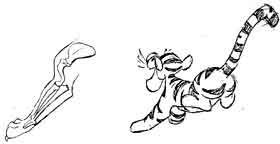
Consider Weight
The pull of gravity is one of the most important principles to deal with in animation. Everything has a certain amount of weight and will act and react accordingly. One easy way to lose the attention of an audience is to have feathers falling like bricks or bricks falling like feathers.
A certain humor can be gotten by bending the rules but should only be used where humor or special effect is called for. In shorts cartoons defying the laws of gravity, weight, speed, squash and stretch, etc., is a the rule of thumb. In Disney feature cartoons such flamboyant abandonment must be handled more discriminately.
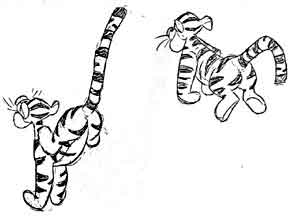
.gif)
.gif)


0 Responses So Far:
Post a Comment